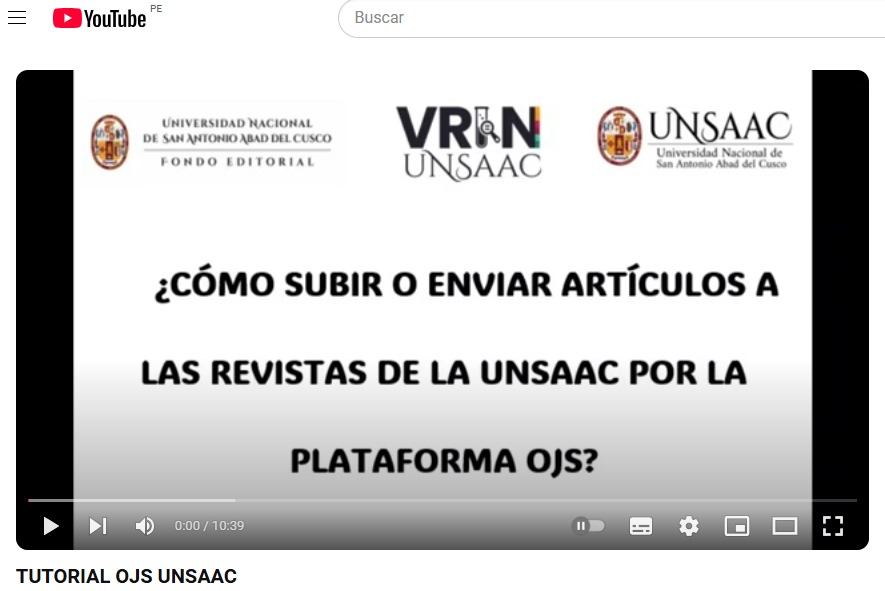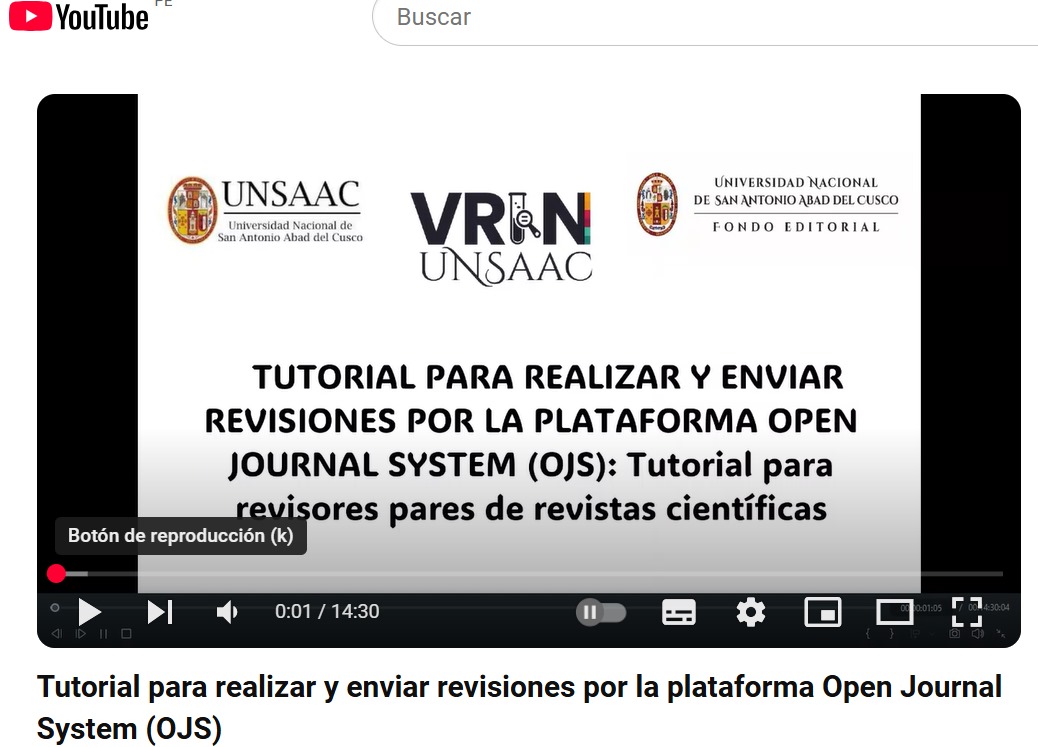Envíos
Lista de comprobación para la preparación de envíos
Como parte del proceso de envío, los autores/as están obligados a comprobar que su envío cumpla todos los elementos que se muestran a continuación. Se devolverán a los autores/as aquellos envíos que no cumplan estas directrices.- El envío no ha sido publicado previamente ni se ha sometido a consideración por ninguna otra revista (o se ha proporcionado una explicación al respecto en los Comentarios al editor/a).
- El archivo de envío está en formato OpenOffice, Microsoft Word, RTF o WordPerfect.
- Siempre que sea posible, se proporcionan direcciones URL para las referencias.
- El texto tiene interlineado sencillo; 12 puntos de tamaño de fuente; se utiliza cursiva en lugar de subrayado (excepto en las direcciones URL); y todas las ilustraciones, figuras y tablas se encuentran colocadas en los lugares del texto apropiados, en vez de al final.
- El texto se adhiere a los requisitos estilísticos y bibliográficos resumidos en las Directrices del autor/a, que aparecen en Acerca de la revista.
REVISIONES SISTEMÁTICAS
Síntesis de las lecturas realizadas durante la fase de investigación documental, seguida de unas conclusiones o una discusión de información.
INFORMES BREVES
Los informes breves pueden limitarse a una pequeña muestra, variables limitadas o estudios piloto.
META ANÁLISIS
Metodología necesaria para acumular rigurosa y eficientemente los resultados cuantitativos de los estudios empíricos.
CARTAS AL EDITOR
Extension incluye una discusión fundamentada, teórica, conceptual o metodología.
ARTÍCULO DE REVISIÓN
El artículo de revisión, se caracteriza por la selección de un tema específico a partir de la literatura cientpifica publicada, y de manera critica propone una perspectiva. Tiene por propósito recopilar información relevante sobre un determinado tópico.
Aviso de derechos de autor/a
Usted es libre de:
- Compartir: Copiar y redistribuir el material en cualquier medio o formato para cualquier propósito, incluso comercialmente.
- Adaptar: Remezclar, transformar y construir a partir del material para cualquier propósito, incluso comercialmente.
Declaración de privacidad
Declaración de Responsabilidad de Autoría
Los firmantes, actuando en nombre y representación propia, en calidad de autores del manuscrito [Nombre del manuscrito], el cual deseamos someter a publicación en la Revista Ambiente, Comportamiento y Sociedad de la Universidad Nacional de San Antonio Abad del Cusco.
DECLARAMOS
- Que hemos contribuido directamente al contenido intelectual del manuscrito; por lo cual estamos en condiciones de hacernos públicamente responsables de él y aceptamos que nuestros nombres figuren en la lista de autores.
- Que el trabajo es original e inédito y que no ha sido enviado o se enviará a otras revistas mientras se espera la decisión de los editores luego de cursar el proceso editorial de publicación de la Revista Ambiente, Comportamiento y Sociedad.
- Que no existe conflicto de interés, en este artículo, que haya afectado la realización del mismo y que de haberlo será expresado en la sección correspondiente.
- Que para la creación del manuscrito no se han vulnerado derechos de autor o de propiedad intelectual de terceros.
- Que la investigación propuesta ha sido aprobada por un comité, ente u organización dedicada a velar por los derechos de los pacientes, personas o animales. Los autores declaramos haber cumplido lo estipulado en la declaración de Helsinki y el código de ética para el uso de animales en experimentación. Aceptamos que responderemos como únicos responsables por cualquier reclamo que en esta materia se pueda presentar, exonerando de cualquier responsabilidad a la “Revista Ambiente, Comportamiento y Sociedad”, al equipo editorial y a los revisores.
- Que los puntos de vista expresados son responsabilidad de los autores y no de la institución en la que trabajan, de la fuente de financiación ni de la “Revista Ambiente, Comportamiento y Sociedad”.
- Que como autor conservo los derechos morales, intelectuales, de privacidad y publicidad del trabajo, por lo que los contenidos son responsabilidad exclusiva del autor.
- Que en caso de que el manuscrito sea aceptado para publicación apruebo que la “Revista Ambiente, Comportamiento y Sociedad” intervenga en el manuscrito (revisión, corrección de estilo, traducción, diagramación), según su pauta de preparación y edición de manuscritos y su posterior divulgación, la inclusión en índices bibliográficos o bases de datos nacionales e internacionales con fines académicos y científicos, respetando los derechos de los autores. Esto se logra mediante una licencia de uso y no a través de una cesión de derechos, lo que representa que la “Revista Ambiente, Comportamiento y Sociedad” se eximen de cualquier responsabilidad que se pueda derivar de una mala práctica ética por parte de los autores.
- Autorizamos a la “Revista Ambiente, Comportamiento y Sociedad” la publicación en medios digitales e impresos de nuestros datos personales e identificadores digitales (nombre, dirección postal, teléfono, correo electrónico, identificador ORCID, entre otros), solo con fines académicos.
Se firma a los [XX] días de [MES] de [AÑO].
|
Rol |
Nombre Completo |
**Actividades o roles durante la ejecución de la investigación |
Correo electrónico |
Firma |
|
Autor principal |
|
|
|
|
|
Coautor |
|
|
|
|
|
Coautor |
|
|
|
|
|
Coautor |
|
|
|
|
|
Coautor |
|
|
|
|
|
Coautor |
|
|
|
|
|
Coautor |
|
|
|
|
|
Coautor |
|
|
|
|
|
Coautor |
|
|
|
|
|
Coautor |
|
|
|
|
|
Coautor |
|
|
|
|
|
Autor de Correspondencia |
|
|
|
|
** Para indicar la participación y roles desempeñados en la investigación se debe utilizar la taxonomía CRediT propuesta en las normas de autoría. Es importante declarar de manera adecuada la labor realizada por cada investigador ya que las mismas definen si se trata de un autor o colaborador del trabajo y serán colocadas en la sección contribución de los autores en el texto del trabajo. Para el llenado de este aspecto se debe colocar en la casilla de cada autor el código o los códigos numéricos (ver tabla anexa) que indican el papel o papeles desempeñados por cada participante en el desarrollo de la investigación.
(Agregar más cuadros en caso de ser necesario. El formato debe ser llenado y firmado para posteriormente ser enviado en formato PDF conjuntamente con el manuscrito).
Taxonomía CRediT para autoría (https://casrai.org/credit/)
|
Código |
Rol o aporte a la investigación |
Definición del rol |
|
1 |
Conceptualización |
Ideas; formulación o evolución de metas y objetivos generales de investigación |
|
2 |
Metodología |
Desarrollo o diseño de metodología; creación de modelos |
|
3 |
Software |
Programación y desarrollo de software; diseño de programas informáticos; implementación del código de computadora y algoritmos de soporte; prueba de componentes de código existentes |
|
4 |
Validación |
Verificación ya sea como parte de la actividad o por separado de la replicación/reproducibilidad general de resultados/experimentos y otros productos de investigación. |
|
5 |
Análisis Formal |
Aplicación de técnicas estadísticas, matemáticas, computacionales u otras técnicas formales para analizar o sintetizar datos de estudio. |
|
6 |
Investigación |
Realizar una investigación o proceso investigativo, desarrolla específicamente los experimentos o la recopilación de datos/pruebas. |
|
7 |
Recursos |
Provisión de materiales de estudio, reactivos, materiales, pacientes, muestras de laboratorio, animales, instrumentación, recursos informáticos u otras herramientas de análisis. |
|
8 |
Curación de Datos |
Actividades de gestión para anotar (producir metadatos), resguardar datos y mantener datos de investigación (incluido el código de software, donde es necesario para interpretar los datos en sí) para su uso inicial y posterior reutilización. |
|
9 |
Redacción-Preparación del Borrador Original |
Creación y/o presentación del trabajo publicado, específicamente redacción del borrador inicial (incluida la traducción sustantiva). |
|
10 |
Redacción-Revisión y Edición |
Preparación, creación y/o presentación del trabajo publicado por parte del grupo de investigación original, específicamente revisión crítica, comentarios o revisiones, incluidas las etapas previas o posteriores a la publicación. |
|
11 |
Visualización |
Preparación, creación y/o presentación del trabajo publicado, específicamente visualización/presentación de datos. |
|
12 |
*Supervisión, Planificación y Ejecución |
Supervisión y responsabilidad de liderazgo para la planificación y ejecución de la actividad de investigación, incluida la tutoría externa al equipo central. |
|
13 |
*Administración de Proyectos |
Responsabilidad de gestión y coordinación de la planificación y ejecución de la actividad de investigación |
|
14 |
*Adquisición de Fondos |
Adquisición del apoyo financiero para la ejecución del proyecto que dio origen a la publicación |
*Para la revista Ambiente, Comportamiento y Sociedad, los tres últimos roles por sí solos no constituyen autoría como lo especifica el ICMJE, los investigadores que posean estas funciones o roles deben haber participado adicionalmente en cualquiera de los otros roles o actividades.









.png)



